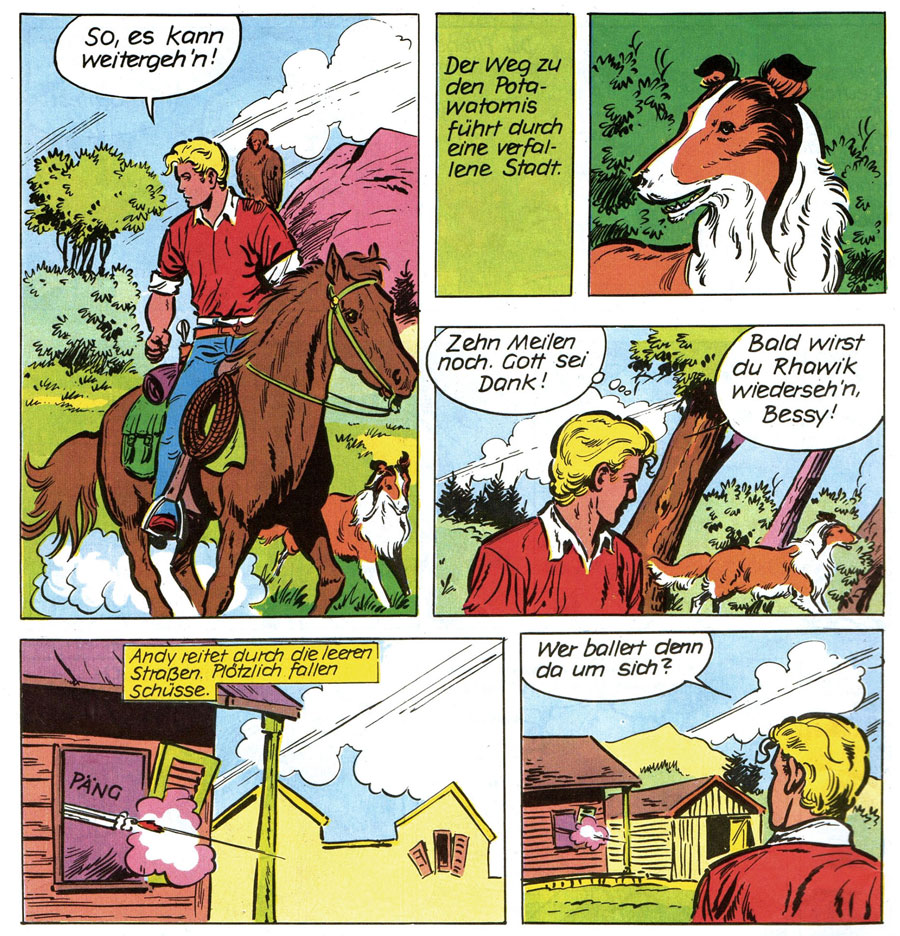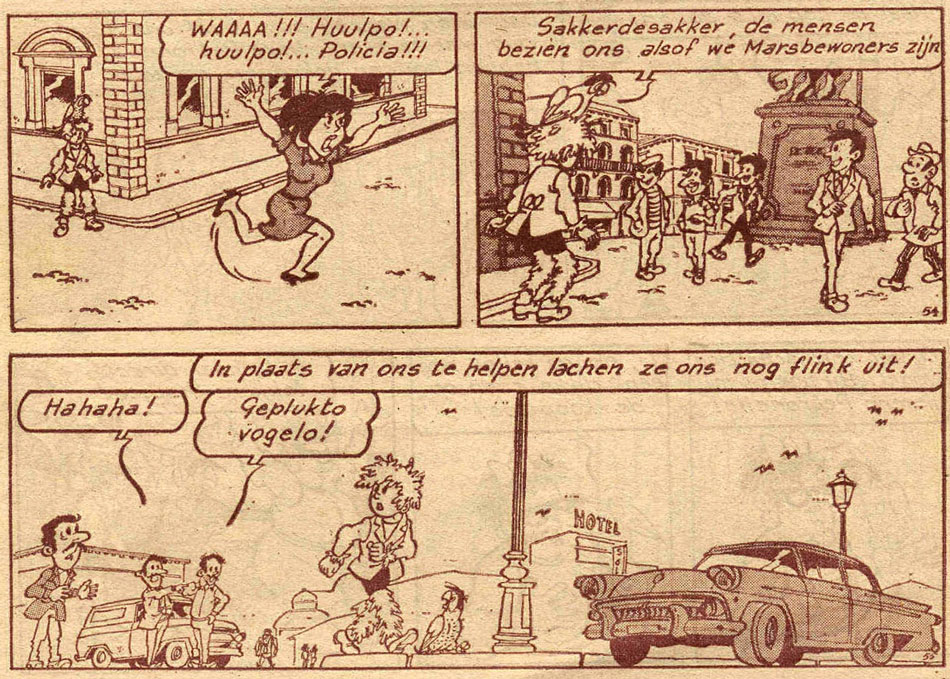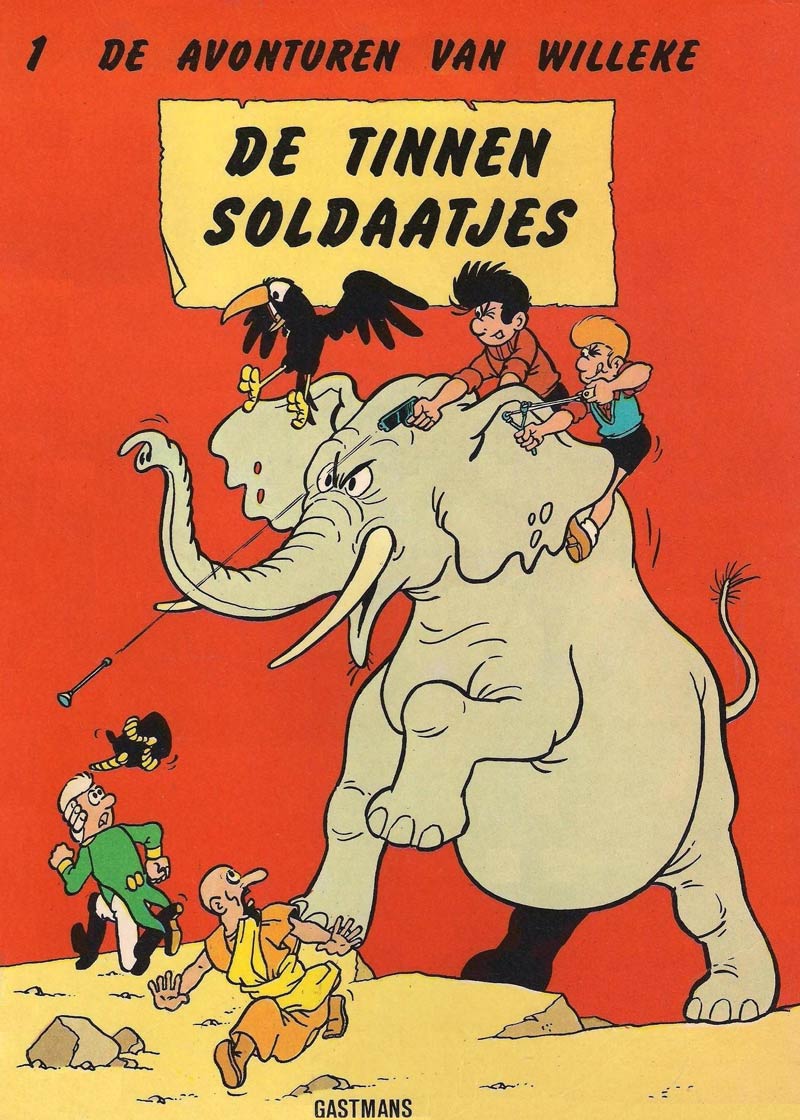Willeke #7 - 'De Tinnen Soldaatjes'.
Edgard Gastmans is a Belgian comic artist, animator and painter. In the late 1960s, he worked for the studio of Willy Vandersteen, alongside Frank Sels, producing stories of the western comic 'Bessy' for German publisher Bastei Verlag. When Sels left Vandersteen, Gastmans joined him in the production of his own western series for the same publisher, 'Silberpfeil'. In the early 1970s, Gastmans was also an assistant of Jef Nys, helping out with his signature children's series 'Jommeke'. After Nys fired him, Gastmans launched his own comic series, 'Willeke' (1972-1974), which gained infamy as shameless plagiarism of 'Jommeke'. Although 'Willeke' sold well, Nys threatened legal action, which led to the comic's cancellation. Since then, Gastmans has concentrated on painting.
Early life and career
Edgard Gastmans was born in 1938 in Antwerp. At the age of twelve, he began his professional career as a colorist for Ray Goossens' animation studio. Between 1954 and 1957, Gastmans studied at the Academy of Fine Arts in Antwerp. When he was 17 years old, he worked as an animator for Raymond Leblanc's animation studio Belvision, doing graphic contributions to their feature film 'Pinocchio Dans L'Espace' ('Pinocchio in Outer Space', 1965). The picture was a critical and commercial flop, but did inspire a comic adaptation, published in Tintin magazine in December of that same year, drawn by Willy Lateste. Gastmans left the animation field and became a commercial designer for the Galerie Anspach department store chain in Brussels.
Studio Bessy
After a short period doing design work, Gastmans applied for a job with Willy Vandersteen's studio and was hired. In 1967, he became part of Vandersteen's separate unit in the Antwerp Grétrystraat, where the stories of the western series 'Bessy' were produced for the German publisher Bastei Verlag. Since 1952, 'Bessy' ran in Dutch and French, but the adventures of the heroic collie proved such a colossal hit in Germany too, that exclusive stories were produced for this market. There, he initially assisted Karel Verschuere on the production of the western series 'Bessy' for the German market, alongside Karel Biddeloo and Frank Sels.
Suffering from personal problems, Verschuere was unfit to lead the team, and his co-workers went to Vandersteen to complain. Gastmans and Sels made their taskmaster a daring proposal. They bragged that they could pull off the same amount of work with just the two of them, promising an increase in quality and cost reduction. As a result, Verschuere was fired, and Biddeloo was relocated to Vandersteen's Kalmthout studio. Gastmans and Sels more or less fulfilled their promise. Between October 1967 and June 1969, they cranked out a complete 28-page 'Bessy' story every week. Daniël Jansens took care of the scripts, while other artists like Eugeen Goossens and Eduard De Rop drew an occasional issue as well. The Sels-Gastmans period took off with the German issue #73, 'Die Wette gilt!', and lasted until issue #158, 'Im Kugelregen am Snow-River' (2 June 1969).
Bessy #158 - 'Im Kugelregen am Snow-River' (1969), the final 'Bessy' story of the Sels-Gastmans team.
Studio Sels
However, Frank Sels had higher ambitions. In late 1968, he struck a personal deal with Bastei Verlag for the creation of a new western series, and Gastmans joined him in this venture. 'Silberpfeil, der Junge Häuptling' ("Silver Arrow, the Young Chieftain", 1969-1986) first saw print on 6 January 1969 in the Bastei magazine Felix. Initially, Gastmans and Sels kept their position at Studio Bessy, so with an additional 14 pages of 'Silberpfeil', they had to produce a total of 42 comic pages each week. 'Silberpfeil' scriptwriter Hugo Renaerts stepped in to pencil an occasional 'Bessy' story too, but it goes without saying that quantity went before quality in this heavy production schedule. Gastmans and Sels had to work day and night to keep up, but Bastei Verlag noticed the decline in quality. With their Vandersteen contract terminated in June 1969, they could devote all their time to 'Silberpfeil'. A bi-weekly 'Silberpfeil' magazine was launched by Bastei in June 1970, while the publication in Felix continued as well. By December 1971, Silberpfeil became a weekly magazine, and the serialization in Felix came to an end. 'Silberpfeil' also ran in Dutch under the title 'Zilverpijl'.
However, Edgard Gastmans didn't stay long at Studio Sels. He made a brief return to Vandersteen's Studio Bessy, until the German publisher noticed he had reworked an older 'Silberpfeil' story into a "new" 'Bessy' episode. The only difference was the main characters. Bastei informed Vandersteen, who immediately fired Gastmans. Since Sels and Gastmans' 'Silberpfeil' was in direct competition with Vandersteen's 'Bessy', their professional relationship soured. Gastmans returned to drawing advertisements, but it wouldn't be the last time in his career that he would be caught with plagiarism.
Jommeke - 'De Fwietmachine'. Filiberke and Flip look different here, because they changed appearance through a failed laboratory experiment by professor Gobelijn. However, the proportionless and stylistically different background characters have no such excuse.
Assistance to Jef Nys
In the early 1970s, Gastmans was an assistant for Jef Nys on his best-selling series 'Jommeke', among other projects. For instance, he worked on the 51st album, 'De Fwietmachine', in which Filiberke and Flip are accidentally teleported to Italy by professor Gobelijn, undergoing a partial body swap. The story was mostly drawn while Nys was on holiday and unavailable for feedback and quality control. When he returned and checked the work his assistants had done on 'De Fwietmachine' in his absence, he felt it looked very sloppy. Many characters move in stiff poses, body and head proportions are often wrong, children and adults sometimes have exactly the same height and perspective is a complete mess. Nys suspected that Gastmans had simply refused to put much effort in it. After a few more warnings, his work still didn't meet Nys' approval, so he fired him. Even years later, Nys maintained that Gastmans had made the most badly drawn 'Jommeke' stories ever. In the late 1990s, 'De Fwietmachine' was one of the albums completely redrawn by his more suitable assistant Philippe Delzenne.
Willeke #1 - 'De Triestige Plant'.
Willeke
In 1972, Gastmans created a comic strip of his own: 'Willeke'. It stars two young boys, Willeke and Bartje, who own a talking crow named Jan. They enjoy typical children's adventure stories, often facing off against the recurring villains Brol and Krol. In addition to adventure episodes, some gag pages were made as well. The debut 'Willeke' story 'De Triestige Plant' appeared as a sticker album distributed by Studio Ridiga through small local stores. For each purchase of 100 Belgian francs (2.5 euros in today's money) people could receive one sticker. With 336 stickers the story could be puzzled together. While the price was expensive, buyers could order the final 20 episodes directly through Gastmans' work address. The marketing tactic worked: 'Willeke' sold well enough to develop into a regular comic series. A total of six comic book albums were published. In 1974, Gastmans signed a contract with a different publisher, Kluwer, which allowed the seventh 'Willeke' story to appear in color. Studio Ridiga also published another sticker album by Gastmans, 'Soldaten Van Alle Tijden', which depicts how soldiers were armoured throughout history.
Willeke #4 - 'De Draak van Kokoluput'.
Controversy
However, 'Willeke' caught the eye of Gastmans' former employer Jef Nys, who felt that the graphic style, lay-out, typography, poses and dialogues looked suspiciously similar to his 'Jommeke' comic. In many ways, the main characters were direct copies of his own cast members. Like Jommeke, Willeke is a blond boy. His black-haired sidekick Bartje is similar to Jommeke's friend Filiberke. Willeke even owns a talking bird, much like Jommeke's parrot Flip. The only difference is that Bartje's pet is a crow, whose ability to talk makes far less sense compared with a parrot. The recurring villains Brol and Krol are rip-offs of the Nys scoundrels Kwak and Boemel. Much to Nys' irritation, the artwork was far better executed than what Gastmans had created when he worked at his studio. The plots were stories Gastmans had once suggested for 'Jommeke', but which Nys had rejected.
At first, Nys simply swallowed his anger, mostly because 'Willeke' was only distributed in small editions. But once publishing company Kluwer brought them out in color, Nys had enough. He sent them a letter, threatening legal action if they continued this decoction of his work. Kluwer instantly obeyed. An eighth story in the 'Willeke' series was finished, but never published. Only two decades later, it was released in a special edition for the Mercator Comic-Con, followed by a reprint of a few 'Willeke' stories by Uitgeverij Bonte.
Gastmans was the first, but not the last comic artist to get into legal trouble with Jef Nys. Between 1994 and 1995, two pornographic parodies of 'Jommeke' were published by an unknown author, under the credit Uitgeverij Thumor, who named the innocent child hero 'Pommeke'. His albums, 'Hete Avonturen' (1994) and 'Erop of Eronder' (1995), featured 'Jommeke' characters in graphic sex scenes, with lots of images directly traced from Nys' albums. This time Nys sued the publisher, Libidos Erotheken, and the court case ended in his favor. All 'Pommeke' stories had to be taken off the market and the remaining copies were given to Nys on legal order. The identity of this porn parody artist has always remained a mystery.
Later career
Since his 'Willeke' debacle, not much has been heard from Edgard Gastmans. He returned to art school and studied sculpting at the Academy of Mol and painting at the Academy of Lier. The man then started a new career in real estate. In the 2010s, his paintings were exhibited in Deurne and Lier.
'Willeke' albums. Note the horse on the second cover, strongly inspired by Jolly Jumper from Morris' 'Lucky Luke' comics.









